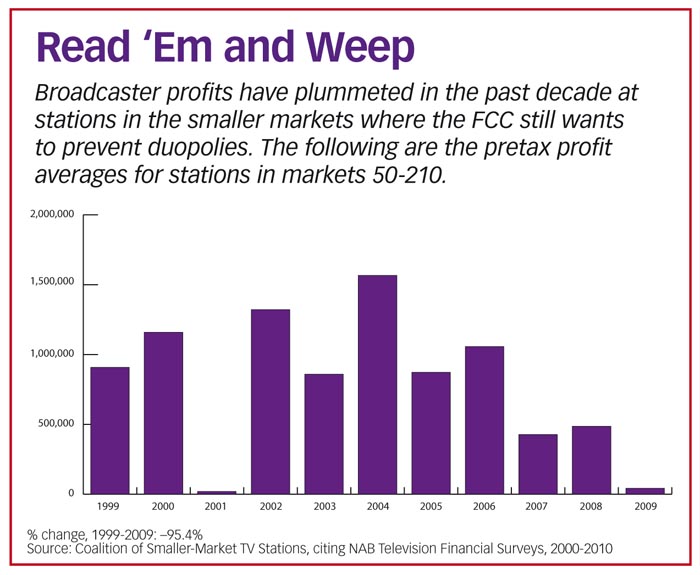5 Keys to Ownership Rules

After a half-decade of stays and remands and court wrangling that are still not over and done with, the Federal Communications Commission has proposed loosening the newspaperbroadcast cross-ownership rules, which it tried to do back in 2007. The commission also wants to leave in place most other media ownership regs that broadcasters argue will kneecap them in the race for the digital future.
With the FCC poised to reclaim a third of remaining TV station spectrum, broadcasters were looking for some slack in the rules—leeway the FCC isn’t planning to give them, except for removing a radio-TV cross-ownership rule that various broadcast sources call a bone with little meat on it. And while the commission is not likely to significantly remake its retrans rules in a separate proceeding, it has given cable operators some hope that it could address that issue through the media ownership proceeding.
Here are five key takeaways from the FCC’s current proposal.
1. Not much help. Because it does not loosen TV duopoly rules or eliminate the newspaperbroadcast cross-ownership ban, the FCC’s proposal does not provide the help broadcasters were looking for. And yes, while it does loosen the TV-radio station cross-ownership ban, which the National Association of Broadcasters asked for, broadcast attorneys speaking on background say nobody was pushing hard for that move anyway.
2. SSA SOS. Broadcasters appear most concerned by the FCC’s signal that it’s looking at counting TV station shared service agreements toward its station ownership caps. That would be a big victory for cable operators that have been pushing the FCC to close what they see as a loophole that allowed stations more muscle in retrans talks. The move would be a back-door way to tighten retrans rules outside the current open petition on retrans.
The FCC wants to know whether shared services agreements, particularly ones involving news sharing, are “substantively equivalent to agreements that are already subject to our attribution rules [which include some local marketing and joint services agreements], and are they therefore attributable today or should they be attributable?”
3. A possible multicasting penalty. The FCC is also raising the spectre of tightening the duopoly rules, citing the extra capacity of multicasting. Broadcasters have been pushing multicasting and its diverse new offerings as a reason for the FCC to leave them enough spectrum to navigate the digital future. But the FCC is using the proliferation of new channels to suggest those might be enough new real estate to justify limiting dual ownerships.
In the NPRM, the FCC asked for comment on whether it should limit TV station owners to one station per market. “[D]oes multicasting replicate the potential benefits to station owners and viewers associated with owning a second in-market station (e.g., efficiency gains and improved programming),” the commission asks, “or are there benefits unique to common ownership that cannot be replicated by multicasting?” The FCC also asks whether it should “limit the ability of station owners to form dual affiliations involving certain networks.” Which leads straight to point 4….
4. Help! According to NAB figures cited by a coalition of small-market broadcasters, TV stations need all the help they can get from the FCC to operate more efficiently—including preserving those joint agreements.
In meetings with FCC commissioners right before the holidays, the Coalition of Small-Market Television stations delivered some sobering numbers to staffers for FCC commissioners Robert McDowell and Mignon Clyburn.
According to data submitted to the FCC and based on NAB TV financial surveys, the pretax profit average for stations in markets 50-210 went from $908,462 in 1999 to only $42,003 in 2009, the last year for which figures were shown. That is a drop of 95.4%. The figures were only slightly better for Big Four network affiliates, dropping from a $1,096,054 average pretax profit in 1999 to only $131,863 in 2009, a precipitous slide of 88%.
5. Over-the-top is still under the radar. The FCC has tentatively concluded, once again, that it should not include over-the-top video as part of the competitive TV station marketplace. “While the growth of MVPDs and Internet delivery of video programming is undeniable, the impact of this growth on the broadcast television industry is unclear,” the agency stated.
That comes even though the FCC’s media bureau has signaled that it expects online to eventually be the country’s video delivery system of choice, and the commission is trying to reclaim broadcast spectrum in part to meet the increasing capacity demands for wireless video downloads.
E-mail comments to jeggerton@nbmedia.com and follow him on Twitter: @eggerton
Broadcasting & Cable Newsletter
The smarter way to stay on top of broadcasting and cable industry. Sign up below
Contributing editor John Eggerton has been an editor and/or writer on media regulation, legislation and policy for over four decades, including covering the FCC, FTC, Congress, the major media trade associations, and the federal courts. In addition to Multichannel News and Broadcasting + Cable, his work has appeared in Radio World, TV Technology, TV Fax, This Week in Consumer Electronics, Variety and the Encyclopedia Britannica.










